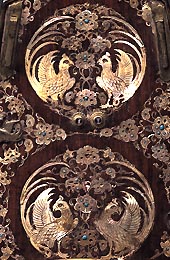Spring
March 16 trough June 10, 1999
The North Wing houses the museum's Japanese Collection, which contains 75 superb works of art, encompassing Korean art, Buddhist art, early modern painting, Tea Ceremony objects, early modern crafts, works by Ogata Kenzan, and more. Highlights from the collection include beautiful blue Korean celadon ceramics; an illustrated Ingakyo Sutra, which dates from the 8th century and still retains its vivid colors; a folding screen by the 16th century painter Hasegawa Tohaku; a sculpture of the Eleven-Headed Kannon, carved during the Heian Period (784 - 1185); and many more. Forty works will be on public display for the first time.
 Plate with poem and landscape design
Kenzan Ware, Edo period, 18th century
|
|
Although it is ceramic ware, this fascinating work is fashioned like a piece of colored paper on which a waka poem is written. The poem is by Fujiwara no Takamitsu and appears in the Shuiwakashu. It reads: "Cherry blossoms lie scattered after the coming of spring. Only their fragrance remain on the branches." The picture of the cherry tree with its petals strewn about adds splashes of brilliance to this work. Once owned by the celebrated officeholder, Inoue, this work was apparently part of a screen that was placed in front of a brazier during the Tea Ceremony.
|
 Green Pine and White Sail
By Ike no Taiga
Edo period, 18th century, hanging scroll, ink on paper |
|
From Taiga's bold brush one can almost breathe in the singular fragrance of newly sprouted pine needles as the wind blows against a rugged tree trunk. The scene commands a view of a sailboat floating in the far distance. This is one of the finest works of Taiga, a master of the Southern-style painting.
|
 Kongõman Bosatsu
Heian period, 12th century, hanging scroll, color on paper
|
|
This Bosatsu (Bodhisattva) holds a woven ribbon. In one corner of the Kongokai mandala, he is depicted as the image parising the principal Buddha, Dainichi Nyorai(Mahavairocana). Even after 700 years the reds and yellows are still brilliant.
|
 Sprinkler, celadon with carved and incised willow and birds design
Korea, Koryo dynasty, 12th century
|
|
This sprinkler, with its well-balanced form, has a refreshing jade-colored glaze.On its surface charming water fowl swim between blooming lotus on a pond.
|



